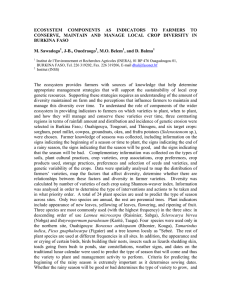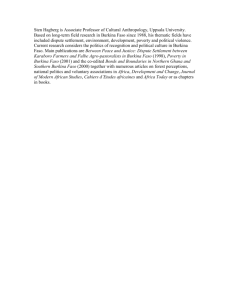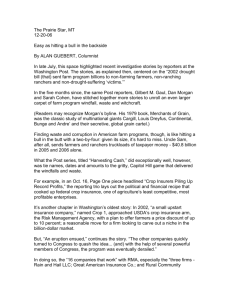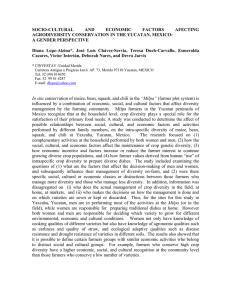ECOSYSTEM COMPONENTS AS INDICATORS TO FARMERS TO CONSERVE, MAINTAIN AND MANAGE
advertisement
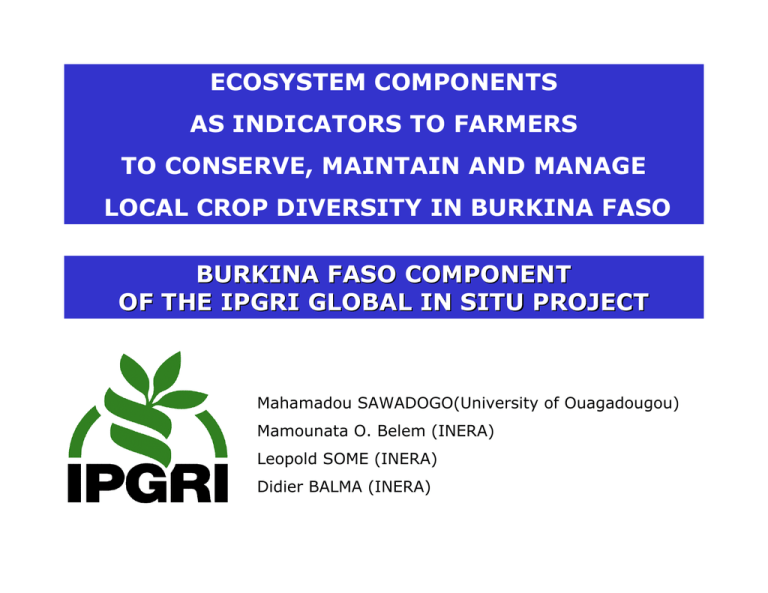
ECOSYSTEM COMPONENTS AS INDICATORS TO FARMERS TO CONSERVE, MAINTAIN AND MANAGE LOCAL CROP DIVERSITY IN BURKINA FASO BURKINA FASO COMPONENT OF THE IPGRI GLOBAL IN SITU PROJECT Mahamadou SAWADOGO(University of Ouagadougou) Mamounata O. Belem (INERA) Leopold SOME (INERA) Didier BALMA (INERA) PURPOSE In BURKINA FASO: • Predict through climate maps and GIS software the probable distribution of Burkina Faso farmer’s varieties across Africa • Determine and map the actual amount and distribution of the diversity of farmer varieties, including endangered and disappeared varieties • Describe the factors that affect this amount and distribution of diversity • Determine and prioritise the type of interventions and actions that support farmer’s management of diversity ASSESSING THE PROBABLE DISTRIBUTION OF DIVERSITY USING CLIMATIC DATA AND MAPPING TOOLS •ArcView, Floramap, Diva, Excel Variance 97,08 Score 2 Probability of Burkina Faso Okra distribution accross Africa SUDAN BURKINA FASO Variance 97,08 % Score 3 Distribution of Burkina Faso and Sudan Okra accross Africa CONCLUSION 1 Using the climate data of okra collection in Burkina Faso we can predict where similar genotypes can be found in other parts of Africa This helps us identify new areas of possible crop diversity for conservation and use ASSESSING THE AMOUNT AND DISTRIBUTION OF DIVERSITY MANAGED BY FARMER CRITERIA FOR SITE/ HOUSEHOLDS SELECTION Burkina Faso Regions Villages <=> <=> Households <=> •Low rainfall •high fluctuation in rainfall •known incidence of genetic erosion •5 or 6 crops - 3 or more varieties per crop •>100 km from Ouagadougou •Presence of NGOs and farmer organizations •selected farmers should have been working with these groups •Interest and commitment of farmers •accessibility of the location throughout the year •permanent and full-time farmer •presence of knowledge about wild relatives •3 or more ethnic groups per village •Variation of rainfall in the village CHOICE OF CROPS Six crops were selected: sorghum Pearl millet Groundnut Reason These are the four most important crops in Burkina Faso Reason This is considered as a woman crop in Burkina Faso Reason This is considered as the most endangered tuber in Burkina Faso Cowpea Okra/ Abelmoschus esculentus Fabirama/ Solenostemon rotundifolius Site I (Ouahigouya) •Northen zone • (a.r.<500mm) • 6 Villages • 18 Households • 312 Household members Project Sites and Active Household members working directely with the project Site II (Tougouri) •Centre-North zone •(400 <a.r.<600 mm) •6 Villages •18 Households •300 Household members Site III (Thiougou) •South-Easth zone •a.r. >1000 mm •6 Villages •18 Households •295 Household members METHOD OF SAMPLING AND DATA ANALYSIS Data sampling (based on participatory approch) • Group discussion • Focus group Interview (based on semi-structured questionnaire and open questions) • Key-informant discussion • Interview of the Head of the household • Transects and ranking DATA COLLECTED Data were collected on the following items: Indigenous knowledge on the Croping season to come •Signs indicating the beginning of a season or planting time •signs indicating the end of a rainy season •signs indicating that the season will be good •signs indicating that the season will be bad •knowledge about changes in seasonal patterns Farmers varieties and consistency of naming varieties Farmer’s criteria for seed selection Farmer’s criteria for: •Different types of soils •Important plant species •Important plant cultural practices •Crop associations •Crop rankings •Objectives for the production of crops CROP DIVERSITY ACROSS VILLAGES VILLAGE Cow pe a Sorghum Pe arl m ille t Groundnut Ok ra Kain 1,0759 1,2558 1,1745 0,8740 0,6659 Bougoure 1,0697 1,6254 1,2817 0,5608 0,6678 Pobe M e ngao 1,0614 1,7594 1,1726 0,8020 0,8785 Noufondou 1,0520 1,4950 1,0398 0,7974 1,0590 Gas s an 1,8045 1,6317 1,2375 1,0244 1,4305 Kougny 0,6899 1,6460 1,0865 0,6867 0,8566 Tougouri 0,7111 1,8054 0,8782 0,7310 1,1365 Sam bte m bila 0,1814 1,5086 0,9997 0,8716 0,7752 Zoom nogo 1,0906 1,6268 1,2205 0,6302 0,6757 Nam as s a 0,6916 1,8166 0,6641 0,6782 0,6931 Pas panga 0,6899 1,2928 0,6929 0,5608 0,5303 Toe yogdin 0,1814 1,8815 0,6723 0,5608 0,1013 Gne taya 0,8156 1,7565 1,2417 1,3424 0,2712 Gnim te nga 0,5589 1,8870 0,5557 0,6066 1,0863 M e de ga 0,1814 1,9536 1,6441 0,6709 1,2749 Yam bas s e 0,6243 1,6712 1,1689 1,4555 1,0583 Safoula 0,5028 2,2466 0,6905 0,5608 1,0972 Thiougou 0,5238 2,4659 1,0669 1,3778 0,6757 M oye nne 0,7503 1,7403 1,0271 0,8218 0,8297 0,40 0,30 0,28 0,29 0,34 0,184787 0,138590 0,129351 0,133971 0,157069 Ecart-type Inte rvalle confi. Legende SITE 1 HIGH SITE 2 MEDIUM SITE 3 LOW Site 1 Site 2 Site 3 CROP DIVERSITY AND PRIORITY ACROSS THE SITES Diversity Managed by Farmers Number of Farmers Threat On diversity Site 1 High Medium High Site 2 Medium Low Low Priority to be ordered FIRST SECOND Site3 Low High Medium THIRD CONCLUSION 2 Crop diversity is found to be: 9Low in Site 3, where the agro-climatic conditions are very good, 9High in Site 1, which is characterized by adverse agro-climatic conditions drought spells, poor soil, desertification). At such risky conditions farmers seem to be using crop diversity as a strategy for survival: here diversity may be a means of life (survival). FACTORS AFFECTING DIVERSITY MANAGEMENT FARMERS’ KNOWLEDGE ABOUT SEASONS The Signs indicating the Beginning of rainy/cropping season or time to plant The Signs indicating that the cropping season will be good The Signs indicating the End of a rainy/cropping season The Signs indicating that the cropping season will be bad The Signs indicating the Beginning of a season or time to plant PLANTS BIRDS DA – Leaf fall of Tamarindus indica,Vitelaria paradoxum (Karite) D1 – Beginning to have leaf of Lannea microcarpa (Sabga), Sclerocarya birrea (Nobga) Flowering of Sclerocarya birrea (Nobga), Lannea microcarpa (Sabga), Pterocarpus lucens(Kumbrsaka),”Perperga” D3 – Yellowing and leaf fall of Lannea acida (Samb-nutuga) D2 – D4 – Appearance of Stylochiton hypogeae (Wule) in the river D7 – Guinea fowls laying eggs D8 – Some birds (Taaba) building their nests D9 – Storks returning (migrating back) to the village D10 – South-North migration of Silokoe and Kilimba birds D11 – Sparrowhawk crying continuously (repeatedly) beds D5 – Maturity and fruiting of Lannea microcarpa (Sabga), Sclerocarya birrea (Nobga), Butyrospermum paradoxum (Taaga) D6 – Ripening, drying and souring of fruits of Lannea microcarpa (Sabga), Sclerocarya birrea (Nobga) D12 – D13 – D14 – Lizards shading skin Toads going to the bush from ponds Toads croaking incessantly RITUALS STARS AND WEATHER D15 – Appearance of the constellation of six stars in the west D16 – Change in the normal trajectory of the sun D17 – Wind blowing from the East D18–Temperatures are warming Dx – First clouds appearing Dy – Continuous thundering ANIMALS D19 – Predictions of rainmakers D20 – Traditional lunar calendar up HOW MANY SIGNS/SOURCES ARE THEY USING? 8,00 7,00 0,67 1,00 1,28 6,00 5,00 2,17 1,54 4,00 3,00 1,50 0,19 0,92 0,18 2,00 1,00 2,50 0,00 Site1 Ritual Stars/Weather Animal Plant 4,04 2,32 Site2 Figure : Average of singns used to predict the beginning of a season Site3 6,00 5,00 0,83 4,00 0,83 3,00 0,50 1,67 0,74 Ritual Stars/Weather 0,70 Animal 1,16 2,00 0,68 0,32 1,00 1,67 1,16 0,00 Site1 Site2 Figure : Average of signs used to predict a good season across sites 1,34 Site3 Plant CONCLUSION 3 • Farmers in all sites have reasonably good knowledge about the beginning of seasons, and the good seasons. • This is indicated by their ability to use a combination of all signs at comparatively good levels. • These signs gives farmers more sources of knowledge & different options for accurate decision-making on cropping seasons. • This in turn has a very vital effect on the maintenance of the crop germplasm diversity by the farmers. WHICH « PLANT-BASED » SIGNS OR INDICATORS ARE MORE USED BY FARMERS TO PREDICT A SEASON ? Uniform fruiting 30,00 Beginning to have leaf 28,38 Maturity and fruiting Bad and nonuniform fruiting 25,00 Flow ering Yellow ing of leaves When the spikes exserts Frequency, % 20,00 15,00 Ripening, drying and souring of fruits Premature shedding of fruits 14,59 seed falls dow n 12,97 Bad flow ering Appearance 10,00 5,00 8,11 7,84 6,76 5,68 Yellow ing of leaves Bad fruiting Good flow ering 3,24 2,70 1,621,35 1,080,81 Beginning to have good leaf 0,54 0,27 Good fruiting and retention of leafs Leaf fall 0,00 All SITE Good germination Bad grow ing Figure : Frequency of using plant signs to predict a season Late 2nd time to have leaf CONCLUSION 4 Uniform fruiting, leaf initiation, and maturity of certain trees are the most plant-based indicators for predicting a season. WHICH SPECIES MOST Table au : PLANT Fre que ncy of plants usARE e d to pre dict a USED s e as on BY FARMERS TO PREDICT A SEASON? Frequency of plants used to predict a season Plant SITE 1 SITE 2 SITE 3 TOTAL 1 Lanne a m icrocarpa (Rais inie r,*s abga) 19,18 19,05 21,85 20,00 2 Scle rocarya birre a (*Nobga) 16,44 19,05 20,17 18,38 3 Vite laria paradoxum (Karite ,*Taaga) 13,70 14,29 11,76 13,24 4 Ficus platyphylla (*Kamsango) 6,16 4,76 5,04 5,41 5 Heeria insignis (*Lebnore) 5,48 4,76 3,36 4,59 6 Acacia albida (*Zaaga) 5,48 3,81 6,72 5,41 7 Ximenia americana (*Lenga) 4,79 4,76 3,36 4,32 8 Diospiros mespilif ormis (*Ganka) 4,11 4,76 3,36 4,05 9 Boscia Senegalensis (*Nabdga) 4,11 3,81 4,20 4,05 10 Loudetia togoensis (*Soutou) 3,42 4,76 2,52 3,51 11 Ceiba pentandra (Fromager) 2,74 0,00 3,36 2,16 12 Borassus aethiopaum mart. (Rhonier, *Koaga) 2,05 0,00 0,00 0,81 13 Pennisetum americanum (millet) 1,37 4,76 0,00 1,89 14 Pennisetum pedicellatum 1,37 4,76 0,00 1,89 15 Adansonia digitata (Baobab, *Toega) 1,37 0,95 1,68 1,35 16 Sterculia setigera or Setigera del. (*Punpuga) 1,37 0,95 1,68 1,35 17 Tamarindus indica 1,37 0,00 0,00 0,54 18 Acacia nilotica (*Perperga ) 0,68 1,90 2,52 1,62 19 Pterocarpus lucens (*Kumbrsaka) 0,68 1,90 2,52 1,62 20 Stylochiton hypogaens (*Wule) 0,68 0,95 2,52 1,35 21 Lannea acida (*Samb-nutuga) 0,68 0,00 2,52 1,08 22 Agricutural crops 0,68 0,00 0,84 0,54 23 Ficus gnaphalocarpa (Figuier) 0,68 0,00 0,00 0,27 24 Plant seedling 0,68 0,00 0,00 0,27 Moyenne 4,14 4,17 4,17 4,16 Ecart type 5,13 5,56 5,81 5,39 2,0530 2,2240 2,3260 2,1550 Inter. Conf i. *- Dénomination locale Conclusion 5 At present, farmers in all sites have rich alternative sources of plant-based knowledge to predict seasons. This is reflected in the large number of plant species that are used in these sites for such purpose. However, many of these important tree species are becoming endangered in the Northern & Central region in Burkina Faso. Thus, it is necessary to adopt an integrated conservation approach, where different disciplines work together towards conserving the components of the surrounding ecosystem together with crop diversity. Lessons Learned • In arid regions of unpredictable rainfall of Burkina Faso, diversity is a way of life. • Managing crop diversity is only strategy available to resource poor farmers to guarantee food from one year to the next. • Farmers rely on indicators from the surrounding ecosystem to manage their crops. • Therefore, it is not possible to talk about conservation of crop diversity on-farm without considering the conservation and valorization of the components of the surrounding ecosystem. Ecosystem components form the base of a pyramid at the top of which are crop genetic resources, and both are linked by the knowledge obtained from the ecosystem and applied on the crop genetic resources. A RELATIONSHIPS PYRAMID BETWEEN CROP GENETIC RESOURCES, FARMERS KNOWLEDGE AND ECOSYSTEM CROP GENETIC RESOURCES FARMERS KNOWLEDGE ECOSYSTEM SURROUNDING FARMERS
